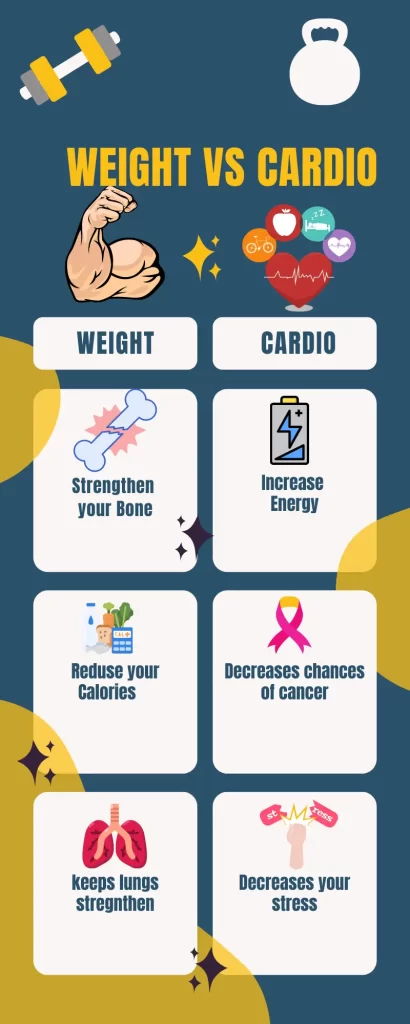While strength training is vital to burn more calories at rest and boost your metabolism, if you want to shed pounds, you also need to do cardio. Cardio exercises to lose weight have to be taken seriously into your exercise regime as it serves many health benefits and leads you to improved health and wellbeing.
What Is Cardio for Weight Loss?
Cardio, short for cardiovascular exercise, refers to any activity that raises your heart rate and keeps it elevated for an extended period. These exercises help improve the efficiency of your heart, lungs, and circulatory system, all while burning calories. Cardio exercises to lose weight focus on increasing energy expenditure, which creates a calorie deficit this is essential for weight loss.
Common cardio activities include:

- Running or Jogging
- Cycling
- Swimming
- Jump Rope
- Aerobics
- HIIT (High-Intensity Interval Training)
These activities involve continuous movement, using large muscle groups, which results in fat loss over time.
How Cardio Helps with Weight Loss:
- Burns Calories: Cardio exercises raise your heart rate and burn calories efficiently.
- Boosts Metabolism: Regular cardio increases your metabolic rate, helping you burn more calories even after the workout.
- Enhances Fat Loss: A consistent cardio routine targets stored fat and helps in reducing body fat percentage.
These benefits highlight the importance of incorporating cardio into your routine, not just for weight loss but for overall health and well-being.
Cardio Workouts for Weight Loss
There are various types of cardio exercises that are particularly effective for weight loss. Each of these can be modified according to your fitness level and personal preferences. Below are some of the most efficient cardio exercises to lose weight:
Exercise 1: Jump Squats
Jump squats are an excellent cardio exercise that strengthens your legs, boosts endurance, and burns calories. Here’s how to do it:
Instructions:
- Stand Tall: Keep your feet shoulder-width apart.
- Squat Down: Lower your body by pushing your hips back and keeping your chest lifted and back straight.
- Jump Up: As you come out of the squat, explode into a jump, raising your arms above your head.
- Land Softly: Land gently on your feet with knees slightly bent and transition immediately into the next squat.
Repetitions:
- Perform 3 rounds of as many reps as you can (aim for 5 to 10 reps) in 45 to 60 seconds.
Exercise 2: Cycling
Recommended by: Fitness professionals worldwide for improving endurance and burning fat.
Cycling is a low-impact cardio exercise that tones your legs, strengthens your core, and burns calories. Whether you cycle outdoors or use a stationary bike, it’s a highly effective workout.
Instructions:
- Adjust Your Seat: Ensure the bike seat is at a comfortable height so that your legs are slightly bent at the bottom of each pedal stroke.
- Warm-Up: Start with a gentle pace to warm up your muscles and get your heart rate up.
- Increase Intensity: Gradually increase your speed or resistance to challenge your muscles and boost calorie burn.
- Cool Down: Slow your pace for the last few minutes to bring your heart rate down.
Repetitions:
- Cycle for 30 to 45 minutes at a moderate pace, or alternate between high-intensity sprints and low-intensity recovery for 20 to 30 minutes.
Exercise 3: High-Intensity Interval Training (HIIT)
Recommended by: Trainers for fast calorie burning and improved cardiovascular fitness.
HIIT alternates between short bursts of high-intensity activity and periods of rest or low-intensity movement. This method maximizes calorie burn in a short amount of time.
Instructions:
- Warm-Up: Start with light cardio, like jogging or jumping jacks, for 5 minutes.
- High-Intensity Phase: Perform an intense exercise (like sprinting, jumping jacks, or burpees) for 20-30 seconds.
- Low-Intensity Phase: Follow with 30-60 seconds of walking or slow jogging for recovery.
- Repeat: Alternate between high- and low-intensity intervals.
Repetitions:
- Perform 8 to 10 rounds for a total workout time of 20 to 30 minutes.
Exercise 4: Jump Rope
Recommended by: Athletes for building stamina, coordination, and burning calories quickly.
Jump rope is a simple yet highly effective full-body cardio workout that improves coordination, increases heart rate, and burns fat.
Instructions:
- Get the Right Rope Length: When standing on the rope, the handles should reach your armpits.
- Warm-Up: Start with basic hops, jumping softly and keeping a steady rhythm.
- Increase Speed: As you get comfortable, increase your jumping speed to burn more calories.
- Use Variations: Mix in different moves like high knees, double unders, or side-to-side jumps for added challenge.
Repetitions:
- Jump rope for 3 rounds of 1 to 2 minutes each, resting for 30 seconds between rounds.
Exercise 5: Swimming
Recommended by: Experts for full-body conditioning and low-impact cardio.
Swimming works nearly every muscle in the body while being gentle on the joints. It’s a great way to improve endurance, build muscle, and burn calories.
Instructions:
- Warm-Up: Start with a slow swim using a stroke you are comfortable with, like freestyle or breaststroke.
- Increase Pace: After warming up, swim at a faster pace for several laps, focusing on strong strokes.
- Mix Strokes: Alternate between different strokes like backstroke, freestyle, and butterfly to target various muscle groups.
- Cool Down: End with a slower, relaxed swim to bring your heart rate down.
Repetitions:
- Swim for 30 to 45 minutes, alternating between fast and slow laps to increase calorie burn.
Exercise 6: Dance Workouts (Zumba, Aerobics)
Recommended by: Instructors for fun, energetic cardio that improves coordination and burns fat.
Dance workouts like Zumba or aerobics combine fun music with calorie-torching dance moves. It’s a full-body workout that’s so engaging, you’ll forget you’re exercising.
Instructions:
- Follow the Beat: Let the music guide your movements, focusing on staying in rhythm with the instructor’s cues.
- Mix Moves: Dance workouts often blend different dance styles like salsa, hip hop, and merengue, keeping it fun and challenging.
- Keep Moving: Even if you miss a step, keep moving to maintain your heart rate.
Repetitions:
- Join a 60-minute class or follow an online dance workout session. Aim for 3 to 5 sessions per week for best results.
Exercise 7: Climbing Stairs
Recommended by: Trainers for building leg strength and burning calories in a short amount of time.
Climbing stairs is an effective cardio workout that strengthens the lower body, tones muscles, and quickly burns calories. You can use a stair machine or any set of stairs.
Instructions:
- Warm-Up: Start by walking up and down the stairs at a comfortable pace for 2-3 minutes.
- Increase Speed: Climb the stairs as fast as you can for 30-60 seconds.
- Use Your Arms: Pump your arms to engage more muscles and increase calorie burn.
- Take Breaks: Rest by walking slowly down the stairs or stepping in place between sets.
Repetitions:
- Perform 10 to 15 sets of climbing, with 30 seconds of rest between sets. You can aim to burn up to 500 calories by climbing 30 flights of stairs.
Best Cardio Exercises for Burning Fat
If your primary goal is weight loss, certain cardio exercises are known to be particularly effective in burning fat. These workouts often involve higher intensity or longer durations, designed to maximize calorie burn.
1. High-Intensity Interval Training (HIIT):
HIIT involves short bursts of intense exercise followed by brief periods of rest. For example, sprinting for 30 seconds and then walking for a minute, repeated for 20 minutes. This method is extremely efficient for burning fat as it elevates the heart rate and keeps your metabolism high even after the workout.
2. Running:
One of the most effective cardio-exercises-to-lose-weight is running. It can burn upwards of 600-900 calories per hour, depending on your speed and intensity. Whether on a treadmill or outdoors, alternating between sprinting and jogging (also known as interval training) can further enhance fat-burning.
3. Rowing:
Rowing machines provide a full-body workout that strengthens both the upper and lower body while torching calories. Even just 20 minutes of rowing can burn a significant amount of fat, making it one of the best exercises for weight loss.
4. Kickboxing:
Kickboxing combines cardio with strength training, which helps in burning fat while toning muscles. It’s a high-energy workout that can burn up to 800 calories in an hour, making it an excellent fat-burning exercise.
5. Stair Climbing:
Climbing stairs is simple but highly effective for burning calories and building lower body strength. Whether you’re using a stair-stepper at the gym or taking the stairs at home or work, this activity can burn fat quickly, especially when done in intervals.
6. Swimming (Freestyle or Butterfly Stroke):
Swimming, particularly the freestyle or butterfly stroke, is highly effective for weight loss. Swimming for an hour can burn 500-700 calories and provide a full-body workout, improving both cardiovascular health and muscle tone.
The Health Benefits of Cardio Exercise
Engaging in regular cardio exercises doesn’t just help you lose weight—it also offers numerous health benefits that improve your overall well-being. Here are some of the top health advantages:
- Improved heart health: Cardio strengthens the heart, enabling it to pump blood more efficiently, reducing the risk of heart disease and high blood pressure.
- Enhanced lung capacity: With regular cardio, your lungs become more efficient at oxygenating your blood, which can improve stamina and energy levels.
- Boosted metabolism: Cardio exercises increase your metabolic rate, which helps you burn more calories even when you’re resting.
- Mental health benefits: Regular cardio can reduce anxiety, depression, and stress, as it releases endorphins, the body’s natural mood boosters.
- Better sleep: Cardiovascular activity has been shown to improve the quality of sleep, helping you fall asleep faster and enjoy deeper rest.
Cardio vs. Diet for Weight Loss
One common debate in the fitness world is whether cardio or diet plays a more significant role in weight loss. The answer is that both are essential components, and they complement each other in achieving optimal results.
Cardio for Weight Loss:
- Burns calories: Cardio exercises are effective in burning a large number of calories, contributing to a calorie deficit, which is necessary for weight loss.
- Improves metabolism: Cardio helps increase your resting metabolic rate, which means you burn more calories throughout the day.
- Builds stamina: Consistent cardio enables you to exercise longer and at higher intensities, which can help burn even more fat over time.
Diet for Weight Loss:
- Caloric intake: No matter how much cardio you do, if you consume more calories than you burn, weight loss won’t happen. Managing your diet is crucial to ensure you’re in a calorie deficit.
- Nutrient quality: A balanced diet rich in whole foods—such as lean proteins, fruits, vegetables, and healthy fats—supports your body’s energy levels and overall health, making it easier to stick to a cardio regimen.
- Sustainable changes: Diet helps establish a sustainable way to manage your weight long-term, whereas cardio accelerates the process by boosting the number of calories burned.
In conclusion, while cardio exercises are great for burning calories and improving overall fitness, they work best when combined with a healthy, calorie-conscious diet.
Potential Risks to Consider
While cardio exercises to lose weight are generally safe for most people, there are a few potential risks to be aware of, especially for beginners or those with underlying health conditions.
- Overtraining: Doing too much cardio without proper rest can lead to overtraining, causing fatigue, muscle soreness, and even injury. Make sure to balance cardio with rest days and strength training.
- Joint Stress and Injuries: High-impact exercises like running or jumping can strain your joints, particularly the knees and ankles. To minimize injury risk, alternate between low-impact activities such as cycling or swimming.
- Burnout: Engaging in the same cardio routine for extended periods can lead to mental burnout. Keep your workouts fresh and fun by trying new forms of cardio, like HIIT or dance-based exercises.
- Neglecting Recovery: Cardio puts stress on your muscles and cardiovascular system, so recovery is essential. Incorporate cool-downs and stretching into your routine to prevent injuries and improve flexibility.
- Ignoring Nutrition: Cardio burns calories, but it’s essential to fuel your body with the right nutrients. Make sure you’re eating a balanced diet rich in proteins, healthy fats, and carbohydrates to support weight loss and muscle repair.
Conclusion
Cardio practice is a simple and viable method for getting in shape economically. It doesn’t need broad gear, and one can without much of a stretch save exercise and preparing related use. Cardio exercises are appropriate for the people who love to resolve outside and the individuals who favor practicing inside their homes. With consistency and a smart dieting plan, cardio activities can assist all kinds of people with accomplishing their drawn out wellbeing objectives.
Read Also




